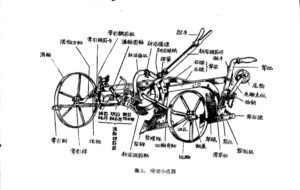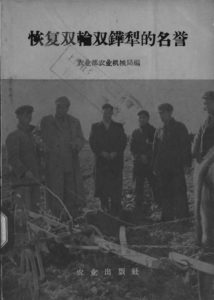Why Did A Plough Matter? (1958)
Why Did A Plough Matter? (1958)
“Do you support adopting two-wheeled, doubled-share plough [双轮双铧犁]?”
Imagine that you were a Chinese farmer earning a living during the late-1950s, and not showing positive attitude to this question; then you might be well running the risk of being labeled as a person of conservative thought [保守思想] or, even worse, a rightist [右派分子]. Just as what a 1958’s commentary in People’s Daily pointed out:
While the system of means of production was undergoing a transition from private ownership to collective ownership, and also two-wheeled double-share plough was spread to replace their old-fashioned counterparts, consolidating the ownership of the collectives, the resentment toward socialism among certain groups of rich farmers, the conservative thought and customary forces of peasants, [……] together with the storms and waves stirred by rightists had converged into a reactionary stream [……] This was the main reason for which two-wheeled double-share plough could not be widely employed.
当生产资料的个体私有制改变为集体公有制的时候,当推广双轮双铧犁来代替旧犁并巩固集体公有制的时候,一些富裕农民对社会主义额抵制情绪及农民保守思想和习惯势力的一面 [……] 再加上右派分子们从中兴风作浪,就一度形成了反对双轮双铧犁的一股逆流 [……] 这是双铧犁不能推广的主要原因。[i]
Yet, why did the very plough matter to such an extent? Or, put it in another way, why was a problem, technical by nature, politicized; why was choosing between farming instruments made a serious indicator of political stand? This is a puzzle, to which researchers are easily tempted to explain with simplification, such as the typical ideology-dominance model in accounting for policy-making in the Maoist period. But this is actually an issue whose implication cannot be properly revealed unless one pays more attention to the decision-making context where it came into being.
The two-wheeled, doubled-share (TWDS) plough was originally an import from the Soviet Union during the First Five-Year Plan. This was the period when the CCP, considering China’s limited industrial capacity, developed a gradual blueprint of agricultural mechanization from the beginning of its reign. At that time, the use of farming machines like tractors was promoted along with the call for improving old-fashioned implements and the innovative ones [改良旧式农具,推广新式农具]. But before long, priority was placed on the latter from the mid-1950s as a transitional step, due to practical constraints such as labor surplus.[ii] Compared to its Chinese counterparts, the animal-drawn TWDS plough is much more complex in structure and, according to some reports, 60% more efficient.[iii] Nevertheless, its shortcomings are also apparent. First and foremost, while the plough was regarded “suitable for cultivating sandy or light clay soils” in a faster and deeper manner, it did not fit “China’s terraced and small farm plots,” especially the rice fields of South China. Moreover, the implement often appeared too complex to be used by peasants with limited technical knowledge, and also too expensive for individual households to afford.[iv]
Despite the disadvantages, TWDS plough became the focal point of a nationwide, state-driven “marketing” from the mid-1950s, and eventually came to be entangled with the struggle between the policy line of “anti-rash advance” [反冒进] and that of “leap forward”[跃进]. In the famous Forty Treaties of Agriculture [农业四十条,the shortened title of 一九五六年到一九六七年全国农业发展纲要草案] formulated in 1956, Mao Zedong dictated that six-million TWDS ploughs should be produced and distributed within three or five years. Corresponding the plan was a mounting momentum of radical collectivization, which would be imposed upon over 90% of rural households by the end of this year, and a sudden surge of investment in GDP.[v] The trend, however, was effectively calmed down by a coalition of moderate leaders, including Zhou Enlai and Liu Shaoqi under the slogan: “oppose rash advance.” On June 20th, a signal commentary in People’s Daily, for example, even cited the improper spread of TWDS plough in South China as an exemplified consequence of unrealistic economic planning.[vi] Although such an orientation was further affirmed by the 8th Congress of the CCP in September, the radicalized adoption of TWDS plough was not curbed. For instance, its excessive production resulted in 1.7 million ploughs in 1956 alone. Only half of the sum was sold to peasants; around one sixth of them were returned, and a large number of ploughs among the rest were also not able to be used, ending up being hanged in farmers’ house [挂在墙上无法使用的“挂犁”].[vii] Into the 1957, however, the changing climate in the international Communist camp brought about an opportunity for Mao, who had been unhappy with the move of anti-rash advance, to contain the moderates. The campaigns of Rectification [整风] and Anti-Rightist [反右] successfully paved the way to Mao’s criticism of “opposing rash advance” in the late 1957. Zhou Enlai and other moderate leaders were forced to step back, making self-criticism and abandoning their cautious stand in economic development.[viii] Accompanying the resurgence of Mao’s line of great-and-fast development [多、快], there was also a movement initiated from the beginning of 1958 to “restore the reputation of TWDS plough” [为双轮双铧犁恢复名誉] across the country. But as aforementioned, now the reason to its unpopularity was largely attributed to the ideological backwardness among peasants and local cadres, and their politically incorrect attack on the “superiority of TWDS plough [双轮双铧犁的优越性].”[ix] A plough, in a sense, was turned a symbol of the triumph of one political line over the other.
Reviewing the episode towards the eve of the Great Leap Forward, the case of TWDS plough is legitimate to invite explanations from, at least, two important aspects of PRC’s policymaking, apart from some conventionally-held ideological factors. The first concerns the underlying pragmatic logic behind the political decision that the universal adoption of TWDS plough is strategically crucial for China’s mechanization of farming. The radical camp led by Mao was apparently not blinded to the weakness of the implement and a number of malpractices regarding the official acts to spread its use.[x] But they seemed to firmly stick to the belief that by continuous technical modification, TWDS plough was possible to be adapted to almost all circumstances of farming. This tendency has been clearly shown by the official propaganda’s emphasis upon “overcoming rightist, conservative thought” [克服右倾保守思想] through many examples of the successful use of TWDS plough in originally unsuited lands.[xi] What actually motivated Mao and relevant decision-makers during the mid-1950s to prefer such a universalism rather than pluralism in the choice of ploughing techniques, however, is not yet known. Further examination, on the one hand, would be devoted to detailed decision-making debates over agricultural mechanization prior to the release of Forty Treaties of Agriculture. On the other hand, it may also pays off in investigating a possible linkage between the use of TWDS plough and Mao and Liu Shaoqi’s conflict over the priority of agricultural modernization. While Liu preferred to postpone collectivization for the sake of achieving the mechanization of farming, the view of Mao was exactly the reverse.[xii] This disagreement, thus, might well motivated Mao to make use of the spread of new implements which individual household could hardly afford, in speeding up the process of organizing collectives. Yet, the confirmation of either possible explanation requires access to more propaganda pamphlets and governmental archives.
Furthermore, the politicization of TWDS plough may both derive explanatory factors from and shed more light on the pattern of alliance-making between central and provincial leaders in the 1950s. A preliminary look of evidence suggests that provincial reactions to the central advocacy of TWDS plough might vary, in accordance with different political interests of provincial leaders and their personal ties to central leaders. Zhejiang province, for example, especially played an active role in promoting the plough throughout the period leading to the restoration of TWDS plough’s reputation in the early 1958, while its party secretariat, Jiang Hua held a strong factional tie to Mao Zedong.[xiii] Also, the provinces that seemed to be most active in promoting TWDS plough were tended to be headed by those secretariats who started to hold their positions from around 1955.[xiv] This phenomenon may indicate the common strategy for the newly appointed provincial leaders to safeguard their ladder of success through reacting more positively to the central line backed by Mao Zedong. Those potential variables, however, have to be interpreted within the broader context of intra-bureaucratic competition between provincial leaders over higher political credentials, whose pattern and impact had been more cleared manifested in the “Wind of Exaggeration” [浮夸风] during the Great Leap Forward.[xv]
In general, the politics surrounding TWDS plough would constitute a promising case study in making sense of the logic of policy-making, and also dynamics between formal and informal institutions of bureaucracy in the early PRC. But in doing so, one should always try to take in to consideration the full range of potential factors behind the scene. Nevertheless, while avoiding leaning solely on ideologies as causes, we should also be aware of the risk to reduce the major actors into purely rational decision makers immune from ideational influence.
Recommended Sources:
双轮双铧犁/农业部农业机械管理局编 – 北京:财政经济出版社,1955.
双轮双铧犁讲话/农村青年社编 – 中国青年出版社,1956.
使用双轮双铧犁问答/浙江省农业厅农业机械管理局编 – 杭州:浙江人民出版社,1956.
恢复双轮双铧犁的名誉/农业部机械局编 – 北京:农业出版社,1958.
中华人民共和国经济和社会发展计划大事辑要, 1949 – 1985/《当代中国的计划工作》办公室 – 北京:红旗出版社, 1986.
人民日报,关于“双轮双铧犁”文章及社论, 1954 – 1959.
[i] 提高双轮双铧犁的使用效率/人民日报,1958.4.16.
[ii] Hsu, Robert C. (1979), “Agricultural Mechanization in China: Policies, Problems, and Prospects,” Asian Survey, Vol. 19, No. 5, p. 437.
[iii] 双轮双铧犁与中国新式农具推广工作/朱显灵 胡化凯 – 当代中国史研究,第16卷,第3期, 2009, p. 57.
[iv] 双轮双铧犁讲话/农村青年社编 – 中国青年出版社, 1956, p. 6; Kuo, Leislie T.C. (1964), “Agricultural Mechanization in Communist China,” The China Quarterly, No.17, pp. 143 – 144.
[v] 一九五六年到一九六七年全国农业发展纲要(草案)/中共中央政治局,1956.1.23; Bramall, Chris (2009), Chinese Economic Development, London & New York: Routledge, pp.122 – 123.
[vi] 要反对保守主义,也要反对急躁情绪/人民日报, 1956.6.20.
[vii] 若干重大决策与事件的回顾(上卷)/薄一波 – 北京:人民出版社, 1991, p. 538.
[viii] 中华人民共和国总路线,大跃进,人民公社化运动始末/宋连生 – 昆明:云南人民出版社, 2001, pp.56 – 59.
[ix] 恢复双轮双铧犁的名誉/农业部机械局编 – 北京:农业出版社,1958.
[x] 提高双轮双铧犁的使用效率/人民日报,1958.4.16.
[xi] 恢复双轮双铧犁的名誉/农业部机械局编 – 北京:农业出版社,1958.
[xii] Hsu, Robert C. (1979), “Agricultural Mechanization in China: Policies, Problems, and Prospects,” Asian Survey, Vol. 19, No. 5, p. 438.
[xiii] See 江华传/《江华传》编审委员会 – 中共党史出版社, 2007.
[xiv] This is measured, for example, by the frequency of appearance on propaganda articles of TWDS plough on People’s Daily; and a complete list of provincial leaders and their tenure from 1949 to 1986 on Bartke, Wolfgang (1987), Who’s Who in the People’s Republic of China 2nd Ed., Munichp[etc]: K.G.Saur.
[xv] 江渭清回忆录/江渭清 – 南京:江苏人民出版社,pp. 428 – 435.
Wang Mingde

